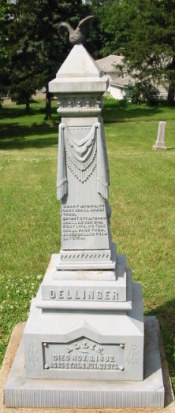|
How to Identify a "Zinker"If you've hung out in cemeteries long enough, sooner or later, you'll spot a "Zinker." One of the more interesting and rare types of markers you'll see in older US cemeteries are the distinctive "White Bronze" markers. These were not made of bronze at all, but cast zinc, hence the nickname. The first producer of zinc markers was the Monumental Bronze Company, which had subsidiaries in Detroit, Chicago and Des Moines. Each of the subsidiaries had its own name, "American Bronze" in Chicago, and "Western White Bronze" in Des Moines. The company was dissolved in 1939. The markers were molded into metallic (but non-magnetic) sheets, shipped from the factory, and assembled by fusing the pieces together with hot zinc. When first cast, these markers were white, but over time they took on a bluish hue. Many of the remaining examples in The most common type were four-sided obelisks, and each side's panel could be customized. The panels could even have a temporary panel with a symbol or plain design, and then, when a new panel was needed, a new one, with family names or inscriptions, could be ordered. The panels are held with basic screws, and could be interchanged quickly and easily. Zinc markers became thought of as "tacky," which is one of the reasons why they fell out of favor so quickly. Ironically, many of these markers have endured in much better shape than their marble cousins, especially in terms of their inscriptions. The inscriptions on zinc markers are often still as clear today as the day they were cast. Another factor contributing to the relative rarity of zinc markers still remaining today is that the material does become quite brittle over time, and if they are struck, they tend to shatter. To identify a marker as zinc, first look for bluish-gray to dark gray markers. The markers will be hollow, and you will be able to see seams along each corner. Another tell-tale sign of a "zinker" are the acorn-like screws (look at the rectangular area on the photo, in each of the corners) jutting out from the inscription panels on the corners. Don't let a marker's size fool you, either. These could as tall as 14 feet! Riverside Cemetery, Denver's pioneer cemetery, has one of the most extensive collections of "zinkers," of any cemetery in the country. Large box-type markers, cherubs, lambs, and crosses of zinc can be found. The military section has a pair of zinc markers, topped with tall Civil War soldiers, one facing toward the main cemetery, guarding the civilian dead and the other watching over his comrades. The tallest of the two was recently restored, and is perhaps one of the most unique zinc markers in the world. The soldier's likeness was custom built with the face of the veteran whose grave he marks.
|
 Colorado have attained a finish of dark gray. These markers were made from about 1870 to 1914, and represent a small window of cemetery art. They were sold in catalogs and by traveling salesmen, and were available in the most common marker styles of the era, but were far less expensive than their counterparts in materials such as marble or granite.
Colorado have attained a finish of dark gray. These markers were made from about 1870 to 1914, and represent a small window of cemetery art. They were sold in catalogs and by traveling salesmen, and were available in the most common marker styles of the era, but were far less expensive than their counterparts in materials such as marble or granite.